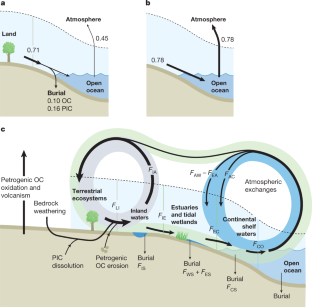2022-04-05 ペンシルベニア州立大学(PennState)
・最近の研究では、陸と海をつなぐ複雑な水域ネットワークを介した炭素の流れが見落とされることが多く、この流れを無視すると陸上生態系の炭素貯蔵量を過大評価し、堆積物や海洋の炭素貯蔵量を過小評価してしまうことが明らかになった。
・海洋による炭素貯蔵と陸上による炭素貯蔵は通常別々に定量化され、内陸水域、河口、潮間帯湿地、大陸棚水域-陸から海洋への水系連続体またはLOACと呼ばれる-を通じた炭素輸送は十分に考慮されない。
・ベルギー、米国、フランスの研究者は、LOACの詳細な分析において、地球規模の炭素循環に関する視点を提供し、国際気候協定の一部である炭素計算の実施に重大な影響を及ぼす主要な知識のギャップを特定しました。研究成果は、3月17日発行のNature誌に報告されました。
<関連情報>
- https://www.psu.edu/news/research/story/carbon-flow-through-inland-and-coastal-waterways-implications-climate/
- https://www.nature.com/articles/s41586-021-04339-9
地球規模の炭素循環における陸から海へのループ The land-to-ocean loops of the global carbon cycle
Pierre Regnier,Laure Resplandy,Raymond G. Najjar &Philippe Ciais
Nature Published: 16 March 2022

Abstract
Carbon storage by the ocean and by the land is usually quantified separately, and does not fully take into account the land-to-ocean transport of carbon through inland waters, estuaries, tidal wetlands and continental shelf waters—the ‘land-to-ocean aquatic continuum’ (LOAC). Here we assess LOAC carbon cycling before the industrial period and perturbed by direct human interventions, including climate change. In our view of the global carbon cycle, the traditional ‘long-range loop’, which carries carbon from terrestrial ecosystems to the open ocean through rivers, is reinforced by two ‘short-range loops’ that carry carbon from terrestrial ecosystems to inland waters and from tidal wetlands to the open ocean. Using a mass-balance approach, we find that the pre-industrial uptake of atmospheric carbon dioxide by terrestrial ecosystems transferred to the ocean and outgassed back to the atmosphere amounts to 0.65 ± 0.30 petagrams of carbon per year (±2 sigma). Humans have accelerated the cycling of carbon between terrestrial ecosystems, inland waters and the atmosphere, and decreased the uptake of atmospheric carbon dioxide from tidal wetlands and submerged vegetation. Ignoring these changing LOAC carbon fluxes results in an overestimation of carbon storage in terrestrial ecosystems by 0.6 ± 0.4 petagrams of carbon per year, and an underestimation of sedimentary and oceanic carbon storage. We identify knowledge gaps that are key to reduce uncertainties in future assessments of LOAC fluxes.


